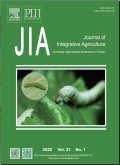农业科学学报(英文)2024,Vol.23Issue(11):3812-3829,18.DOI:10.1016/j.jia.2024.04.030
Glomerular organization in the antennal lobe of the oriental armyworm Mythimna separata
Glomerular organization in the antennal lobe of the oriental armyworm Mythimna separata
Baiwei Ma 1Qi Chen 2Xi Chu 3Yidong Zuo 2Jiayu Wang 4Yi Yang 2Guirong Wang 5Bingzhong Ren2
作者信息
- 1. Jilin Provincial Key Laboratory of Animal Resource Conservation and Utilization,School of Life Sciences,Northeast Normal University,Changchun 130024,China||Key Laboratory of Vegetation Ecology,Ministry of Education,Northeast Normal University,Changchun 130024,China||State Key Laboratory for Biology of Plant Diseases and Insect Pests,Institute of Plant Protection,Chinese Academy of Agricultural Sciences,Beijing 100193,China
- 2. Jilin Provincial Key Laboratory of Animal Resource Conservation and Utilization,School of Life Sciences,Northeast Normal University,Changchun 130024,China||Key Laboratory of Vegetation Ecology,Ministry of Education,Northeast Normal University,Changchun 130024,China
- 3. Chemosensory Lab,Department of Psychology,Norwegian University of Science and Technology,Trondheim 7491,Norway
- 4. State Key Laboratory for Biology of Plant Diseases and Insect Pests,Institute of Plant Protection,Chinese Academy of Agricultural Sciences,Beijing 100193,China
- 5. State Key Laboratory for Biology of Plant Diseases and Insect Pests,Institute of Plant Protection,Chinese Academy of Agricultural Sciences,Beijing 100193,China||Shenzhen Branch,Guangdong Laboratory for Lingnan Modern Agriculture,Synthetic Biology Laboratory of the Ministry of Agriculture and Rural Affairs,Agricultural Genomics Institute at Shenzhen,Chinese Academy of Agricultural Sciences,Shenzhen 518120,China
- 折叠
摘要
关键词
antennal lobe/glomerulus/olfactory sensory neuron/projection neuron/antennal-lobe tract/Mythimna separataKey words
antennal lobe/glomerulus/olfactory sensory neuron/projection neuron/antennal-lobe tract/Mythimna separata引用本文复制引用
Baiwei Ma,Qi Chen,Xi Chu,Yidong Zuo,Jiayu Wang,Yi Yang,Guirong Wang,Bingzhong Ren..Glomerular organization in the antennal lobe of the oriental armyworm Mythimna separata[J].农业科学学报(英文),2024,23(11):3812-3829,18.基金项目
This work was supported by the National Natural Science Foundation of China(32130089),and the Norwegian Research Council(324379). (32130089)

